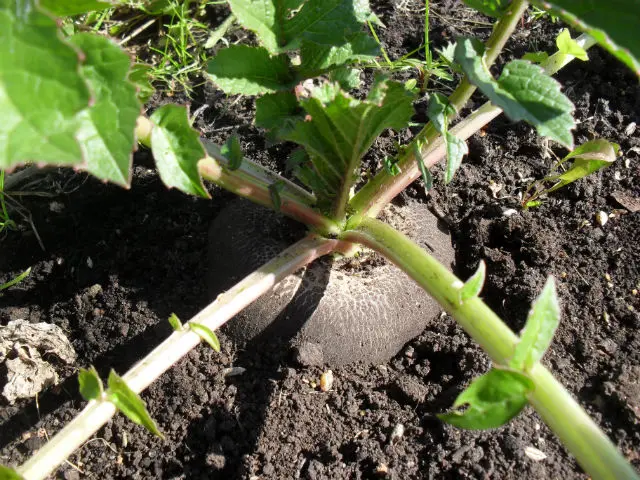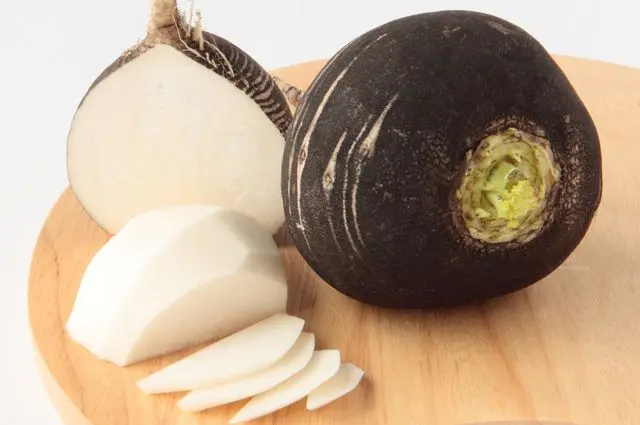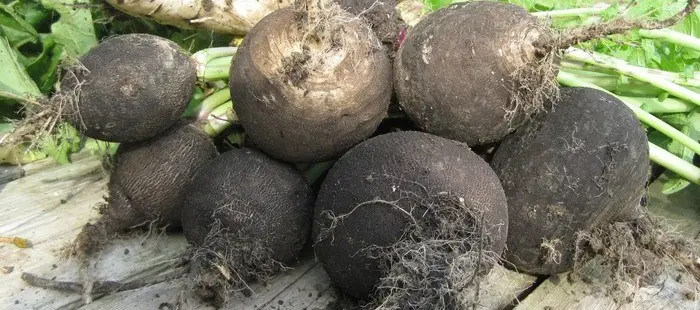Contents


Black radish is considered the most useful of all varieties of this vegetable crop. Even our ancestors grew it not only as a food product, but also as a medicinal plant. Although black root crops lose in taste to other types of radish, they are superior to many natural remedies in terms of the composition of nutrients and healing properties. Growing black radish is not difficult and even exciting: it can grow in any conditions and does not need complicated care. In addition, black winter radish has the longest shelf life, which allows it to be consumed from autumn to spring.
Description
Black radish is a two-year vegetable crop of the Cabbage family. In the first year, the plant forms a root crop and a rosette of basal leaves, and in the second year it expels a tall (up to 60 cm) erect stem with an inflorescence, from which a pod with seeds is then formed. The leaves of the radish are lyre-shaped, dissected, green or grayish in color, slightly rough. The flowers are small, purple or white, collected in racemose inflorescences. The fruits of the plant are long pods containing up to 10 g of black spherical seeds.
Only root crops are used for food, the shape of which is round, oblong or conical. The mass of root crops can vary from 180 to 500 g, the diameter is 8-10 cm for round vegetables and 4-5 for long ones.
The peel is thin, but very dense, black or dark gray in color. Under the peel is a white juicy pulp containing many useful substances, vitamins and biologically active compounds. The taste of radish is similar to radish, but due to the high content of essential oils, it has a pronounced burning taste.
Asia is considered the birthplace of the radish. In the CIS countries, only its cultivated species grow. Propagated by seeds, which are sown for summer harvest in early spring, and for winter – in the second half of summer, however, most varieties of black radish are winter, so harvest is carried out in late autumn. Vegetables are stored very well and for a long time, which allows them to be consumed from autumn to the end of spring.
Video “All about black radish – from seed to harvest”
From the video you will learn how to grow a radish.
Cultivation
Agrotechnics and caring for black radish are not particularly difficult. The culture is frost-resistant, so its cultivation is possible in any, even the coldest climate. For summer harvest, radish is sown in late March – early April, but since most varieties are winter, sowing of black radish is carried out mainly in mid-July in order to get a harvest by autumn.
Even a novice vegetable grower knows how to grow black radish. First you need to prepare a site for planting a crop – for summer sowing, a bed is prepared in the spring: it is dug up by 25-30 cm, and fertilized (humus, compost, superphosphate, potassium salt) if the soil is not fertile enough. If sowing is carried out in the spring, then the preparation of the beds is carried out in the fall. Root crops grow well in loose loamy or sandy loamy soil with neutral acidity, so it is desirable to achieve such characteristics in a designated area.
When the bed is ready, holes or rows are made in it, in which seeds are planted in nests (3-4 each). For radish, planting according to the 20×40 scheme is preferable, where 20 cm is the distance between plants, and 40 cm is the distance between rows, but varieties with long root crops can be planted more densely. Seeds are planted in moist soil to a depth of 2-3 cm, covered with earth, slightly compacted. To simplify plant care, many vegetable growers mulch the garden, but this is not necessary. Sprouts appear quite quickly – on 5-7 days, and if under the film, besides, the seeds were germinated, then it is possible after 3 days.
Further care for the radish consists in regular loosening and weeding (if there is no mulch), watering as needed, 2-3 top dressings during the growing season. As a top dressing, you can use special complex soluble mixtures “Aelita – vegetable”, “Kemira”. During the ripening period of root crops, it is necessary to add potassium – the taste of vegetables depends on this element. The crop is harvested as the root crops grow to the desired size. The ripening period of black radish depends on varietal characteristics and can be 65-100 days.
Varieties of radish
A simple consumer might think that black radish is a separate variety, but this concept is generalized. Radish with black root crops, like other types of crops, has many varieties and hybrids, the most common of which are:
- Winter black. The most popular and long-cultivated winter variety. The roots of this radish are the richest in mineral salts, vitamins and essential oils (this is evidenced by their pronounced bitter taste), and in terms of useful properties they are comparable to garlic. A variety of medium-late (75-100 days) ripening. The root crop is round, large (240-500 g), the surface is smooth, black in color. The flesh is white, very dense, spicy in taste. The radish is perfectly stored, intended for the winter use.
- Murzilka. Late (90-100 days) variety for winter use. Root crops are round, rather large (diameter 8-10 cm, weight 210-300 g). The peel is grayish-black, rough, dense. The pulp is white, juicy, medium spicy. In cool conditions, root crops are perfectly preserved until spring.

- Chernavka. Late-ripening (100-110 days) winter variety of domestic selection. Root crops are large (up to 340 g), even, rounded. The peel is black, rough. The pulp is dense, very juicy, delicate, sweetish-spicy taste. The radish of this grade has a fine trade dress, is stored for a long time.
- Night. Mid-season (70-85 days) domestic variety, included in the State Register of the Federation. Designed for private and industrial cultivation. Root crops of an attractive appearance: round, aligned, intense black color. The average weight is 230-350 g, the pulp is white, soft, slightly spicy taste, very juicy, crispy. The yield of the variety is 3,5-4 kg / 1 sq. m. Long stored, well transported.

- Negress. Another winter variety, entered in the State Register as a crop intended for cultivation in subsidiary farms. Ripening period 75-90 days. The leaves are grayish-green, the rosette is compact. Root crops are large (up to 300 g), rounded, slightly elongated, black in color. The pulp is creamy, dense, soft taste. Suitable for summer cultivation and autumn harvest.
- Black dragon. Mid-early (50-65 days), black radish with dietary properties and a mild, mild taste. Root crops are long (12-17 cm), cylindrical in shape, pointed towards the bottom, of medium weight (150-210 g). The peel is smooth, black, the flesh is white, dense, but very juicy. It is stored for a long time without loss of taste, suitable for winter consumption.
- Doctor. Mid-season variety (75-85 days) of domestic selection. Root crops are round, elliptical, large (up to 280 g). The peel is black in color, the flesh is white, crispy, medium spicy. Productivity is high – up to 4,5 kg / 1 sq. m. Well stored during the winter.

- Peak lady. Mid-season variety (62-70 days), intended for winter consumption, is included in the State Register of the Federation. The root crop is cylindrical, pointed, large size (350-500 g). The peel is black, dense, the flesh is light, the taste is slightly sharp. The variety is resistant to the formation of arrows, minimal care is required. Productivity is high – up to 6 kg / 1 sq. m.
Useful Properties
The healing properties of black radish are recognized not only by folk, but also by traditional medicine.
Of all natural products, it has the most powerful therapeutic effect, and, in fact, is a natural antibiotic due to the presence of glycosides in root crops – substances that have an antimicrobial effect.
The inclusion of radish in the daily diet helps to significantly improve the general condition, strengthen the immune system, the heart and nervous systems, and look younger.
Since ancient times, black radish has been used as a folk remedy for the treatment of:
- colds and viral diseases (tonsillitis, runny nose, cough, including whooping cough) – radish juice with honey effectively relieves coughing attacks, and gruel from grated pulp can be applied instead of mustard plasters for pneumonia;
- to restore and cleanse the liver – fresh juice has an excellent choleretic effect;
- pain and swelling in the joints – radish juice with honey, vodka and salt, when rubbed, quickly relieves pain, the mixture can also be taken orally;
- to improve digestion – juice and salads from fresh root vegetables eliminate congestion in the stomach and intestines, kill bacteria, restore flora, remove toxins;
- cleansing blood vessels from cholesterol
- strengthening hair, nails, enhancing their growth – the juice and gruel of root crops are rubbed into the skin;
- to stop the growth of malignant tumors.
The most curative remedy for most diseases is radish juice mixed with honey. Drinking a glass of drink daily, you can get rid of beriberi, regulate the water-salt balance and restore metabolic processes. It is useful to include root vegetables in the menu in the spring, when the body especially needs vitamins and trace elements. Remember that in terms of the content of esters and phytoncides, which determine the bitter taste of the vegetable, radish is comparable to garlic and horseradish, so include a healthy product in your diet as often as possible.
Video “Useful properties of black radish”
From the video you will learn what healing and beneficial properties the radish has.
Author: Svetlana Galitsina
Loading…












